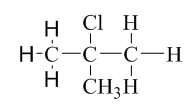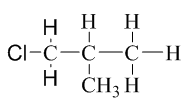
Chemistry: The Molecular Science
5th Edition
ISBN: 9781285199047
Author: John W. Moore, Conrad L. Stanitski
Publisher: Cengage Learning
expand_more
expand_more
format_list_bulleted
Concept explainers
Question
Chapter 7, Problem 30QRT
(a)
Interpretation Introduction
Interpretation:
Chiral centers in the given molecule have to be circled.

Concept Introduction:
Chirality: It refers to a Carbon atom in a molecule that contains four different substituents.
(b)
Interpretation Introduction
Interpretation:
Chiral centers in the given molecule have to be circled.

Concept Introduction:
Refer to (a).
(c)
Interpretation Introduction
Interpretation:
Chiral centers in the given molecule have to be circled.

Concept Introduction:
Refer to (a).
(d)
Interpretation Introduction
Interpretation:
Chiral centers in the given molecule have to be circled.

Concept Introduction:
Refer to (a).
Expert Solution & Answer
Want to see the full answer?
Check out a sample textbook solution
Students have asked these similar questions
What is the [OH⁻] of a 1.80 M solution of pyridine (C₅H₅N, Kb = 1.70 × 10⁻⁹)?
What is the percent ionization in a 0.260 M solution of formic acid (HCOOH) (Ka = 1.78 × 10⁻⁴)?
Determine the pH of solution of HC3H5O2 By constructing an ICE table writing the equilibrium constant expression, and using this information to determine the pH. The Ka of HC3H5O2 is 1.3 x 10-5
Chapter 7 Solutions
Chemistry: The Molecular Science
Ch. 7.2 - Identify the electron-region geometry, the...Ch. 7.2 - Based on the discussion so far, identify a...Ch. 7.2 - Prob. 7.2PSPCh. 7.2 - Determine the electron-region geometry and the...Ch. 7.2 - Prob. 7.2CECh. 7.2 - Prob. 7.3ECh. 7.2 - Prob. 7.4PSPCh. 7.4 - Using hybridization and sigma and pi bonding,...Ch. 7.4 - Prob. 7.4CECh. 7.5 - Decide whether each molecule is polar and, if so,...
Ch. 7.5 - Prob. 7.5ECh. 7.6 - Prob. 7.8PSPCh. 7.6 - Prob. 7.7CECh. 7.6 - Prob. 7.9PSPCh. 7.7 - Prob. 7.8CECh. 7.7 - Prob. 7.9CECh. 7 - Write the Lewis structures and give the...Ch. 7 - The structural formula for the open-chain form of...Ch. 7 - Describe the VSEPR model. How is the model used to...Ch. 7 - What is the difference between the electron-region...Ch. 7 - Prob. 3QRTCh. 7 - Prob. 4QRTCh. 7 - If you have three electron regions around a...Ch. 7 - Prob. 6QRTCh. 7 - Prob. 7QRTCh. 7 - Prob. 8QRTCh. 7 - Prob. 9QRTCh. 7 - Prob. 10QRTCh. 7 - Prob. 11QRTCh. 7 - Prob. 12QRTCh. 7 - Prob. 13QRTCh. 7 - Prob. 14QRTCh. 7 - Prob. 15QRTCh. 7 - Prob. 16QRTCh. 7 - Write Lewis structures for XeOF2 and ClOF3. Use...Ch. 7 - Write Lewis structures for HCP and [IOF4]. Use...Ch. 7 - Prob. 19QRTCh. 7 - Prob. 20QRTCh. 7 - Explain why (I3)+ is bent, but (I3) is linear.Ch. 7 - Prob. 22QRTCh. 7 - Prob. 23QRTCh. 7 - Give approximate values for the indicated bond...Ch. 7 - Give approximate values for the indicated bond...Ch. 7 - Prob. 26QRTCh. 7 - Compare the FClF angles in ClF2+ and ClF2. From...Ch. 7 - Prob. 28QRTCh. 7 - Prob. 29QRTCh. 7 - Prob. 30QRTCh. 7 - Prob. 31QRTCh. 7 - Describe the geometry and hybridization of carbon...Ch. 7 - Describe the geometry and hybridization for each C...Ch. 7 - Describe the hybridization around the central atom...Ch. 7 - The hybridization of the two carbon atoms differs...Ch. 7 - The hybridization of the two nitrogen atoms...Ch. 7 - Identify the type of hybridization, approximate...Ch. 7 - Prob. 38QRTCh. 7 - Prob. 39QRTCh. 7 - Prob. 40QRTCh. 7 - Prob. 41QRTCh. 7 - Methylcyanoacrylate is the active ingredient in...Ch. 7 - Prob. 43QRTCh. 7 - Prob. 44QRTCh. 7 - Prob. 45QRTCh. 7 - Prob. 46QRTCh. 7 - Which of these molecules has a net dipole moment?...Ch. 7 - Prob. 48QRTCh. 7 - Use molecular structures and noncovalent...Ch. 7 - Prob. 50QRTCh. 7 - Explain why water “beads up” on a freshly waxed...Ch. 7 - Explain why water will not remove tar from your...Ch. 7 - Prob. 53QRTCh. 7 - Prob. 54QRTCh. 7 - Prob. 55QRTCh. 7 - Prob. 56QRTCh. 7 - The structural formula for vitamin C is Give a...Ch. 7 - Prob. 58QRTCh. 7 - Prob. 59QRTCh. 7 - Prob. 60QRTCh. 7 - Prob. 61QRTCh. 7 - Prob. 62QRTCh. 7 - Prob. 63QRTCh. 7 - Prob. 64QRTCh. 7 - Prob. 65QRTCh. 7 - Prob. 66QRTCh. 7 - Methylcyanoacrylate is the active ingredient in...Ch. 7 - Prob. 68QRTCh. 7 - Prob. 69QRTCh. 7 - Use Lewis structures and VSEPR theory to predict...Ch. 7 - In addition to CO, CO2, and C3O2, there is another...Ch. 7 - Prob. 72QRTCh. 7 - Prob. 73QRTCh. 7 - Prob. 74QRTCh. 7 - Prob. 75QRTCh. 7 - In the gas phase, positive and negative ions form...Ch. 7 - Prob. 77QRTCh. 7 - Prob. 78QRTCh. 7 - Prob. 79QRTCh. 7 - Prob. 80QRTCh. 7 - Prob. 81QRTCh. 7 - Prob. 82QRTCh. 7 - Prob. 83QRTCh. 7 - Prob. 84QRTCh. 7 - Prob. 85QRTCh. 7 - Prob. 86QRTCh. 7 - Prob. 87QRTCh. 7 - Prob. 88QRTCh. 7 - Prob. 89QRTCh. 7 - Prob. 90QRTCh. 7 - Prob. 91QRTCh. 7 - Prob. 92QRTCh. 7 - Prob. 93QRTCh. 7 - Prob. 94QRTCh. 7 - Which of these are examples of hydrogen bonding?Ch. 7 - Prob. 96QRTCh. 7 - Prob. 97QRTCh. 7 - Prob. 98QRTCh. 7 - Halothane, which had been used as an anesthetic,...Ch. 7 - Ketene, C2H2O, is a reactant for synthesizing...Ch. 7 - Gamma hydroxybutyric acid, GHB, infamous as a date...Ch. 7 - There are two compounds with the molecular formula...Ch. 7 - Piperine, the active ingredient in black pepper,...Ch. 7 - Prob. 105QRTCh. 7 - Two compounds have the molecular formula N3H3. One...Ch. 7 - Prob. 108QRTCh. 7 - Prob. 109QRTCh. 7 - Prob. 110QRTCh. 7 - Prob. 111QRTCh. 7 - Prob. 7.ACPCh. 7 - Prob. 7.BCPCh. 7 - Prob. 7.CCPCh. 7 - Prob. 7.DCP
Knowledge Booster
Learn more about
Need a deep-dive on the concept behind this application? Look no further. Learn more about this topic, chemistry and related others by exploring similar questions and additional content below.Similar questions
- Determine if the following salt is neutral, acidic or basic. If acidic or basic, write the appropriate equilibrium equation for the acid or base that exists when the salt is dissolved in aqueous solution. If neutral, simply write only NR. Be sure to include the proper phases for all species within the reaction LiNO3arrow_forwardAn unknown weak acid with a concentration of 0.410 M has a pH of 5.600. What is the Ka of the weak acid?arrow_forward(racemic) 19.84 Using your reaction roadmaps as a guide, show how to convert 2-oxepanone and ethanol into 1-cyclopentenecarbaldehyde. You must use 2-oxepanone as the source of all carbon atoms in the target molecule. Show all reagents and all molecules synthesized along the way. & + EtOH H 2-Oxepanone 1-Cyclopentenecarbaldehydearrow_forward
- R₂ R₁ R₁ a R Rg Nu R₂ Rg R₁ R R₁₂ R3 R R Nu enolate forming R₁ R B-Alkylated carbonyl species or amines Cyclic B-Ketoester R₁₁ HOB R R₁B R R₁₂ B-Hydroxy carbonyl R diester R2 R3 R₁ RB OR R₂ 0 aB-Unsaturated carbonyl NaOR Aldol HOR reaction 1) LDA 2) R-X 3) H₂O/H₂O ketone, aldehyde 1) 2°-amine 2) acid chloride 3) H₂O'/H₂O 0 O R₁ R₁ R R₁ R₁₂ Alkylated a-carbon R₁ H.C R₁ H.C Alkylated methyl ketone acetoacetic ester B-Ketoester ester R₁ HO R₂ R B-Dicarbonyl HO Alkylated carboxylic acid malonic ester Write the reagents required to bring about each reaction next to the arrows shown. Next, record any regiochemistry or stereochemistry considerations relevant to the reaction. You should also record any key aspects of the mechanism, such as forma- tion of an important intermediate, as a helpful reminder. You may want to keep track of all reactions that make carbon-carbon bonds, because these help you build large molecules from smaller fragments. This especially applies to the reactions in…arrow_forwardProvide the reasonable steps to achieve the following synthesis.arrow_forwardIdentify which compound is more acidic. Justify your choice.arrow_forward
- Provide the reasonable steps to achieve the following synthesis.arrow_forwardWhen anisole is treated with excess bromine, the reaction gives a product which shows two singlets in 1H NMR. Draw the product.arrow_forward(ii) Draw a reasonable mechanism for the following reaction: CI NaOH heat OH (hint: SNAr Reaction) :arrow_forward
arrow_back_ios
SEE MORE QUESTIONS
arrow_forward_ios
Recommended textbooks for you
 Chemistry: The Molecular ScienceChemistryISBN:9781285199047Author:John W. Moore, Conrad L. StanitskiPublisher:Cengage Learning
Chemistry: The Molecular ScienceChemistryISBN:9781285199047Author:John W. Moore, Conrad L. StanitskiPublisher:Cengage Learning Chemistry for Engineering StudentsChemistryISBN:9781337398909Author:Lawrence S. Brown, Tom HolmePublisher:Cengage Learning
Chemistry for Engineering StudentsChemistryISBN:9781337398909Author:Lawrence S. Brown, Tom HolmePublisher:Cengage Learning Introductory Chemistry: An Active Learning Approa...ChemistryISBN:9781305079250Author:Mark S. Cracolice, Ed PetersPublisher:Cengage Learning
Introductory Chemistry: An Active Learning Approa...ChemistryISBN:9781305079250Author:Mark S. Cracolice, Ed PetersPublisher:Cengage Learning Chemistry & Chemical ReactivityChemistryISBN:9781337399074Author:John C. Kotz, Paul M. Treichel, John Townsend, David TreichelPublisher:Cengage Learning
Chemistry & Chemical ReactivityChemistryISBN:9781337399074Author:John C. Kotz, Paul M. Treichel, John Townsend, David TreichelPublisher:Cengage Learning Chemistry & Chemical ReactivityChemistryISBN:9781133949640Author:John C. Kotz, Paul M. Treichel, John Townsend, David TreichelPublisher:Cengage Learning
Chemistry & Chemical ReactivityChemistryISBN:9781133949640Author:John C. Kotz, Paul M. Treichel, John Townsend, David TreichelPublisher:Cengage Learning Chemistry: Principles and PracticeChemistryISBN:9780534420123Author:Daniel L. Reger, Scott R. Goode, David W. Ball, Edward MercerPublisher:Cengage Learning
Chemistry: Principles and PracticeChemistryISBN:9780534420123Author:Daniel L. Reger, Scott R. Goode, David W. Ball, Edward MercerPublisher:Cengage Learning

Chemistry: The Molecular Science
Chemistry
ISBN:9781285199047
Author:John W. Moore, Conrad L. Stanitski
Publisher:Cengage Learning

Chemistry for Engineering Students
Chemistry
ISBN:9781337398909
Author:Lawrence S. Brown, Tom Holme
Publisher:Cengage Learning

Introductory Chemistry: An Active Learning Approa...
Chemistry
ISBN:9781305079250
Author:Mark S. Cracolice, Ed Peters
Publisher:Cengage Learning

Chemistry & Chemical Reactivity
Chemistry
ISBN:9781337399074
Author:John C. Kotz, Paul M. Treichel, John Townsend, David Treichel
Publisher:Cengage Learning

Chemistry & Chemical Reactivity
Chemistry
ISBN:9781133949640
Author:John C. Kotz, Paul M. Treichel, John Townsend, David Treichel
Publisher:Cengage Learning

Chemistry: Principles and Practice
Chemistry
ISBN:9780534420123
Author:Daniel L. Reger, Scott R. Goode, David W. Ball, Edward Mercer
Publisher:Cengage Learning